#Group in Crinolines
Explore tagged Tumblr posts
Text

do you think the axe throwing place will let me wear my hoop skirt with these rules?
#it IS relaxed and comfortable!#yes I'm looking at their group rates for my birthday and yes my birthday is like seven months away#my brain is already in October ok?#I wore a sweatshirt ONCE last week and it is officially fall in my head#no I haven't finished my skirt yet#the crinoline is on the list for this week#and depending on how Saturday goes I may be able to at least start the skirt itself#and then build the rest of the outfit from there#mine
5 notes
·
View notes
Text
i know you all blindly love niigo way more than any other group but also. if mizuki wins that match i think you guys are just voting off of character and not outfit. hide crinoline is a Mess don't lie to yourself
#<- JOKE <3333 silly <333333333333#anyway. not like i can see the votes or anything so i don't actually know whos winning. but i get. a feeling.#based on the influx of votes to that one poll compared to the rest of this round. much like last round#there are just certain matches (cough cough) that draw in a lot more votes for. whatever reason (COUGH COUGH). very strange
33 notes
·
View notes
Text

The Pledge
Danny crept through the window of the old house. It used to be a sorority house ages ago. Nobody remembers, or will say, what happened there, but it closed and was boarded up. Everyone said it was haunted. There were rumours of people going inside and never returning. Danny was determined. Being small and shy he mostly kept to himself. He wanted to get into one of the fraternities at his college, in the hopes that it would help with his self esteem, maybe even make him popular. The task was simple. Go inside, and return with something to prove he had been inside.

As he began his exploration the window slammed shut, trapping him inside.
As he wandered through the house, he thought he heard voices. Whispers. Some were unintelligible, but others were clear.
“This is the one”, “Finally the curse will be lifted”, “We will be complete again”
As he crept through the darkened house he found a door. As he entered he found a room full of the fullest, silkiest dresses he’d ever seen.
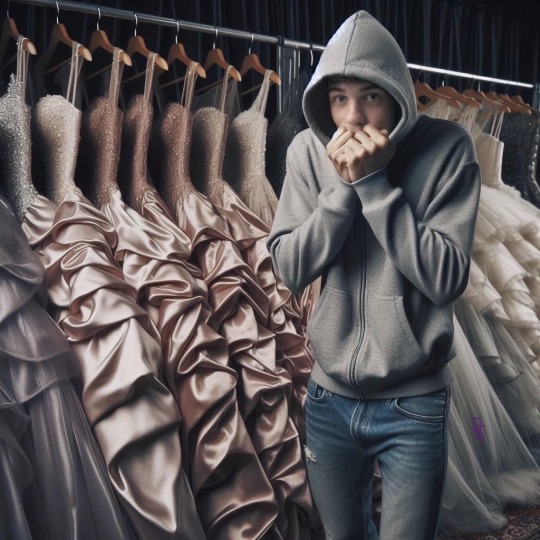
The voices continued. “She’s here. She’s finally here” “our sisterhood is complete” Danny tried to make sense of it but he just ended up more confused. Walking through the house, he found many rooms filled with dresses. As he entered one, suddenly he felt very strange. His clothing started to change, the denim and cotton turning to satin.

He ran to another room. Another room full of dresses. “How many rooms are in this house” he thought. The changes continued. His pants shortened into satin shorts with lace and bows. “What is happening” he cried out. He didn’t expect a response and was shocked when he got one. “You’re finally here, we are complete”
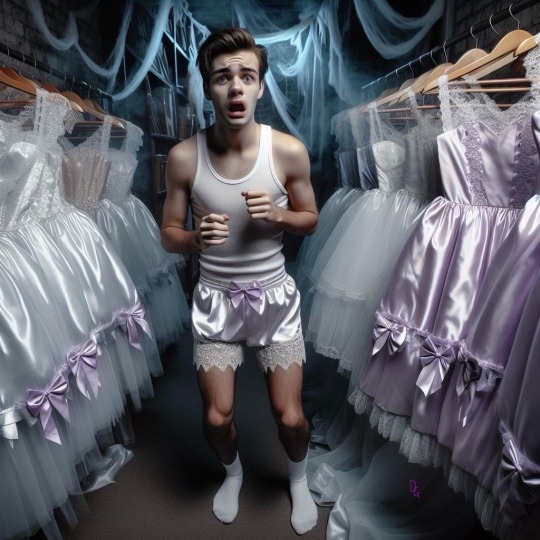
“I have to get out of here” he thought. Running to yet another room, the changes continued. His clothes changed again, growing more full as his hair grew longer. His features started changing too. His face softening his hips and chest swelling. “You’re finally home Danni, welcome!”
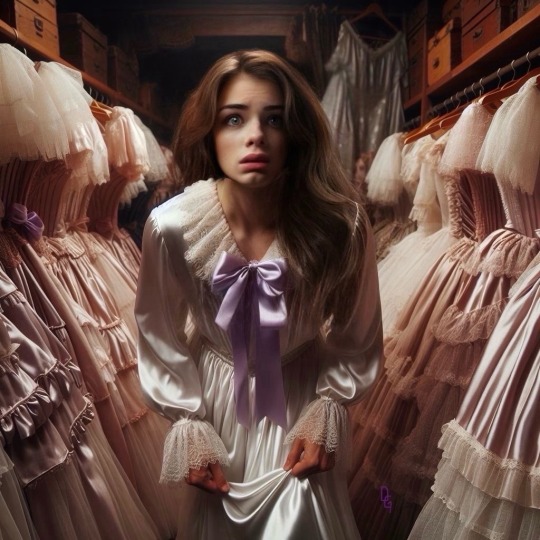
Danni ran out of the room into a hallway and froze as he saw his reflection in the large mirror at the end of the hall. “Im a… is that me? Shocked at his reflection he turned and ran into another hallway.

She encountered a group of women. All dressed as she was. In beautiful satin dresses with lots of bows and crinolines. The women spoke to her. “Welcome Danni. You are now part of the sorority. We are complete” we will have so much fun together.”
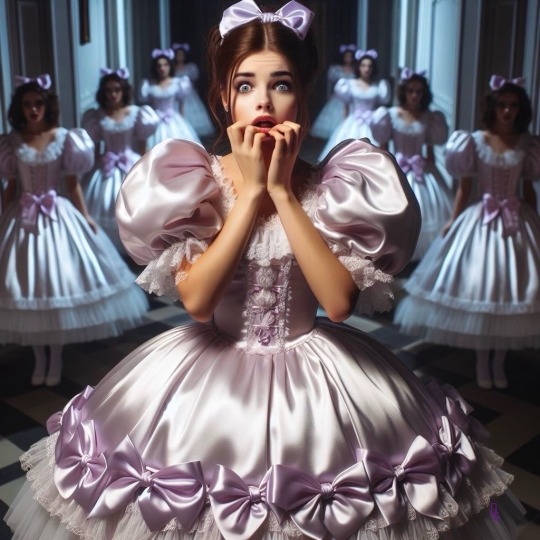
Complete. One of us. Welcome. Danni felt calmed by their words. Happy even. She was accepted. She smiled as she realized that this was where she was meant to be.

“The curse has finally been lifted” said the other women. Danni soon felt at home in her new sorority. Everything changed on campus. Nobody remembered Danny or the supposedly haunted sorority house. All they knew was the sorority with the pretty girls who always wore super pretty dresses and they all knew Danni. The new girl who became so popular around the college. Always smiling on her way to cosmetology , art or fashion design classes, which she excelled at. She was finally who she needed to be.
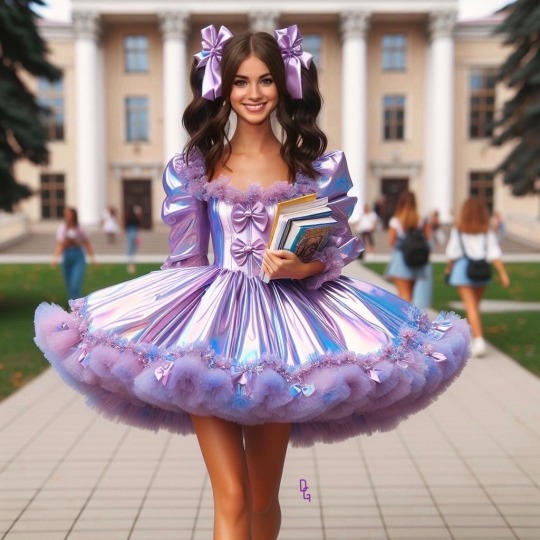
100 notes
·
View notes
Text
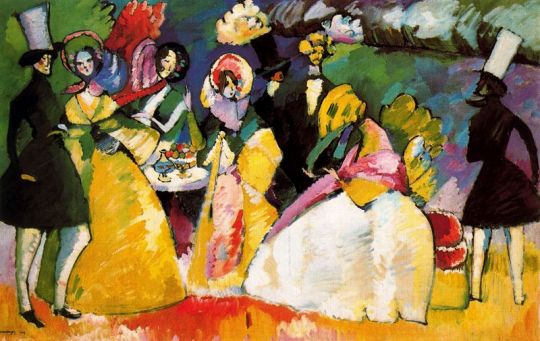
-Group in Crinolines-
69 notes
·
View notes
Note
🥺 please make a drabble 🥺 about Therese 🥺 Raquin x reader 🥺 where Therese is jealous 🥺on the girls that keeps flirting Reader to haberdashery 🥺 and tries to be dominant in bed when she's nothing but a bottom cockwhore lady 🥺🥺🥺

thérèse raquin & gn!reader
tags: smut, fluff, jealousy, possessiveness, degradation, praise, reader has a penis, sub!thérèse raquin, dom!reader. MINORS DNI.
summary: Thérèse is a wild card by nature, but there are some things about her that just can't be changed.

Thérèse peeks over her armful of green satin fabric rolls as she steps down from the staircase, observing the conversation between you and the small flock of girls gathered in front of the counter. She represses a roll of her eyes as she listens to them giggle behind their hands and exchange whispers about you though they’re standing right in front of you.
She wonders if they sincerely intend for their incessant pestering to be charming.
“My mother always told me to bed a tailor,” one of the girls giggle out.
You straighten the sleeve of the silk robe on the table, making quick work of stitching up the loose threads of the hemming.
“Is that so?” you ask, sounding at least partially-interested.
As Thérèse climbs onto a stepstool and slides the rolls of fabric into the wooden shelf behind you, she listens to the conversation with her back turned.
The girl hums in affirmation.
“Nimble fingers,” she elaborates.
Heat rises up Thérèse’s neck to her cheeks and she feels hot fury bubbling up in her. She turns her head and looks down at the group of girls in front of the shop’s counter. She comes down from the stepstool and looks over your shoulder to see you finishing up the customer’s sleeve.
Quickly, Thérèse lays out a paper wrap. She pushes your hands out of the way. She closes up the stitching before cutting the thread and putting the needle and thread to the side.
“Y/N can do the work on their own, miss,” a girl protests.
Thérèse looks up from the dress and glares at her. “Oh, it’s no trouble at all,” she says. “Either way, I wouldn’t want to strain my partner’s pretty fingers.”
Both you and Thérèse weren’t overt with your relationship, thus the usage of ‘partner’ was ambiguous and applied to professional partnerships while still certainly implying romance, if not a relationship that was at the very least explicitly carnal with the way her eyes darted over to you.
She folds the dress up carefully then tucks it away in the paper wrap. She tapes it closed then ties it all together with twine. With her eyes still flickering over the girls, each one looking contrite as they lost the opportunity to have you serve them instead of her, Thérèse slides over the packaged dress.
She reminds, “Formal clothing is meant to be dropped off in the afternoon and picked up at a later time.”
When the girls exchange a look, Thérèse speaks up again. “It’s policy,” she adds sternly. “To be fair to our other customers.” She slides the dress further up the counter and one of the girls finally takes it.
“Good day,” Thérèse dismisses contemptuously.
You’re taking your rings off in front of the vanity mirror when Thérèse steps into the bedroom and closes the door behind her. “Is the shop locked up?” you ask. You look back at her through the mirror and smile at her as she meets your eyes and begins unbuttoning her dress.
She nods in response then hangs up her crinoline on the hook beside the vanity. Then she steps beside you and leans down to kiss your neck.
Before you can even begin to take pleasure in her soft kisses, Thérèse whispers, “I did not enjoy seeing you fraternise with our guests earlier, Y/N.”
You turn your head to look at her and she straightens to look down at you.
“What are you on about?” you inquire and your eyebrows push together.
“I’d bet you stiffened at the sight of them,” she says. She leans down and cups your sex. “Show me how you did.” Her hand tightens around you, fingers pressing through the fabric of your undergarments.
“Thérèse, what has gotten into you?”
She takes your chin in her hand and angles your face up to her.
“Show me,” she insists. “Or it is only other girls that get you stimulated?” Thérèse lifts you from the seat and moves you towards the bed. She sits you down and begins stripping her final layer of clothing until she’s bare whilst you do the same.
You move backwards on the bed, trying to repress your amused grin as Thérèse climbs onto your lap and takes your cock into her hand. Her tongue peeks out from her mouth as she runs its tip across her upper lip at the feeling of how hard you are.
Thérèse moves onto her knees and lowers herself carefully. Your hands wrap around her waist then rub up and down her back, feeling the gentle slope of her spine with your fingertips. She lowers herself until she can run the tip of your cock through her folds. She shudders and her resolve begins to fracture.
Her fingers squeeze around you gently and her hand pumps you shakily as her hips begin to roll forward, craving more friction. You feel her push you upwards through her folds until she nudges you against the hood of her clit. Her eyes shut and she leans against you, her breasts pressed up against your chest with her cheek against yours.
When she dips you in and out of her opening, finally eliciting trembling whimpers from her, she moves her hips down to lower herself onto your dick.
You wrap your hands around her waist and push her back up. She attempts to conceal her disappointment at your action but a frustrated exhale through her nose slips out anyways. She reaches to her side and takes hold of your hand to try and swat it away, but you tighten your grip around her waist and Thérèse lifts her head to look at you.
“Beg,” you say simply.
“No,” she answers, shooting you a defiant look. “Just let me—”
You keep her body held upwards, her cunt just inches away from the tip of your cock. “I’m going to bed if you don’t beg,” you tell her.
Her gaze darts up at you, searching your eyes for any sort of hint that you were teasing her. Unfortunately for her, she finds nothing but sincerity. Her lips twitch and she nearly scowls before she comes to her senses and realises that she has a lesser chance of receiving your mercy if she gave you attitude.
With an inquisitive tip of your head, you prompt her further.
“F-Fine,” she forces out. “Fine. P… Please fuck me. Please. I want your cock.”
“I can’t understand you when you mutter, Thérèse.”
“I said, please fuck my pussy,” she begs. “I’m begging. Please, Y/N.”
In the silent stare exchanged between the two of you, Thérèse admits to being nothing but your pathetic pet, a desperate whore ready to take your cock whenever you should feel like fucking her. And in the way you bend her over with her face pressed against the pillow while she drools and moans out like a braindead slut, you reassure her that you could want no other but her.
You have her say she belongs to you and that her cunt is yours, how wet her pussy gets just thinking of taking your dick into her holes, of having your head between her thighs while you eat her out. You tell her how pretty she looks, how proud you are to own her, and most importantly, how no other could ever take her place as your special girl.
She falls asleep in your arms reassured and confident in the reciprocity of her love for you. Thérèse dozes off with a small smile on her lips for she knows that no one on Earth, let alone in all of France, could ever have you the way she does. You are Thérèse’s as much as she is yours, and that brings her a great amount of pride.
#thérése raquin#thérése raquin smut#thérése raquin x reader#thérése raquin fanfiction#in secret fanfiction#elizabeth olsen#in secret
406 notes
·
View notes
Text

The Empress Eugénie Surrounded by Her Ladies in Waiting
Artist: Franz Xaver Winterhalter (German, 1805–1873)
Date: 1855
Medium: Oil on canvas
Collection: Musée du Second Empire, Compiègne, France
Description
Taking its inspiration from 18th-century bucolic scenes, this monumental composition sets the sovereign and her entourage against the backdrop of a shady clearing in a forest, (evoquing certain 17th-Century compositions representing Diana and her companions such as those by Rubens or Van Loo). However, the composition is very artificial and formal. The Empress, slightly to the left of centre, is encircled by and dominates the group. To her right sits the Princesse d’Essling, chief lady in waiting, to whom she is offering some honeysuckle. To her left, is the Duchesse de Bassano, matron of honour. Before her sit the Baronne de Pierres and the Vicomtesse de Lezay-Marnésia, both ladies in waiting. In the foreground is Comtesse de Montebello; to the right are three other ladies in waiting, the Baronne de Malaret, the Marquise de Las Marismas and the Marquise de la Tour-Maubourg. In striking contrast to the rustic setting, the ladies in waiting rival each other in vestimentary luxury. Each one is wearing her finest ball gown, thus giving the painter a pretext for a virtuoso display of material painting, even to the detriment of the likenesses. In fact the real subject of this glorification of the crinoline is the silk, tulle, muslin, taffeta, lace and ribbons. Only the simplicity of the jewelry seems to match the pastoral setting.
#painting#oil on canvas#group portrait#empress eugenie#french history#french empress#pastoral setting#ladies in waiting#ball gown#forest#flowers#empress of the french#women#silk#tulle#muslin#taffeta#lace#ribbons#franz xaver winterhalter#german painter#artwork#oil painting#fine art#french culture#19th century painting#1855
10 notes
·
View notes
Text
TMAGP EP7 and TMA spoilers!
Heya everyone! So, while listening to the Magnus Protocol episode 7., one cannot but wonder what all of the little things mean because trust me, there is plenty to Dissect.
In this post i would like to focus specifically on the contents that were brought into the building in the recounting of happenings kindly provided to us.
What the weird people bring inside includes:
Plant in a pot shaped like a shouting skull
Bear skin
Chandelier of dark glass
Oversized gramophone and records with religious praying songs
Crudely carved rocking horse
Old grandfather clock leaking dark fluid
Vandalised set of Encyclopedia Britannica
Abstract canvas artworks
Pair of soiled crinoline dresses
Chaise lounge with cushions full of sand
Taxidermy vulture
Rusty antique printing press
Recently used medical equipment
Leather kite
Weirdly curved telescope
Wheelbarrow of shifting fossils
Armful of swords
Lengths of rope
Bathtub full of mouldy food
Stack of old dental retainers
A brace of half-butchered pheasants (a brace is a unit of measurement)
Jars with pickled hands
Ancient diving suit full of sawdust
Picnic hamper full of china
Imperial coins
🔥🔥 F I R E 🔥🔥
(Hilltop road itself???)
(Security guy???)
And I know we are not supposed to analyse TMAGP through the lense of TMA, but please, indulge me for a minute. Let's try and look which fear could use each of these items.
The Eye
Encyclopedias
Curved telescope
The Spiral
Abstract paintings
Shifting fossils
The Flesh
Jar of hamds :3
Stack of dentures
The Lonely
Chaise lounge (sand->lonely beach)
rocking horse (incredibly lonely toy)
The Vast
Diving suit
Kite
The Dark
Chandelier
Gramophone? (Callback to the cult of desacrated host)
The End
Clock
Antique printing press (It's old and rusty?)
The Desolation
The fire?!?? duh?
China hamper (she stepped on it and destroyed it)
The Slaughter
Bunch of swords
Medical equipment
The Hunt
Pheasants
(Security guy???)
The Corruption
Tub of rot
Dresses (They are soiled)
The Stranger
Bear skin
Vulture taxidermy
The Buried
Skull pot
Imperial coins (She literally got buried in them)
The Web
The lengths of rope
(Hilltop itself???)
I personally find it to be very convenient that all of these would be so neatly divided into groups of two, with very distinct fear allocations, with only a few such as the gramophone necessitating a bit of a leap in reasoning.
Few more notes
Hilltop road could probably be counted as the web as it is the hole in spacetime on which the mother of puppets resided but also through which the fears got pulled through/out
All for a good cause? Such as bringing on the apocalypse??? It is a good thing that need more than just to have a bunch of stuff in one place for that.
That boss of hers taking a vacay for who knows how long, who knows where? Very Gertrude-coded
The new girl in the OIAR definitely knows something... very specific questions she asked
#tma spoilers#tmagp 7#tmagp spoilers#tmagp#Thank you to my dear friend M. for being my brainstorm buddy#the magnus protocol
27 notes
·
View notes
Text
It’s not just the dead who disappear in the mirrored corridor of reproduction—the living do, too. Siegfried Kracauer describes the process with photographic precision in his essay on photography: we can break down what our attention does to a photo of our grandmother into its various phases, how she literally disappears before us, vanishes into the folds of her crinoline, leaving only a collar, a chignon and a skirt bustle on the surface of the image. The same thing happens to us. With every new selfie we take, every group shot or passport photo, our lives become arranged into a chain of images, a history which is quite different from the one we tell ourselves and want others to believe. The line of was-and-will-be, a compendium of single moments, poses, mouths open to speak, blurry chins, none of which we chose ourselves. Balzac foresaw some of this and refused to have his photograph taken, reflecting that each new picture removed a layer of balzac, pared it away, and if you let it happen, soon nothing would be left of you (or what would be left was only a puff of smoke, the vegetable heart, and the very last layer, the thickness of a death mask).
—Maria Stepanova, In Memory of Memory tr. Sasha Dugdale
10 notes
·
View notes
Text
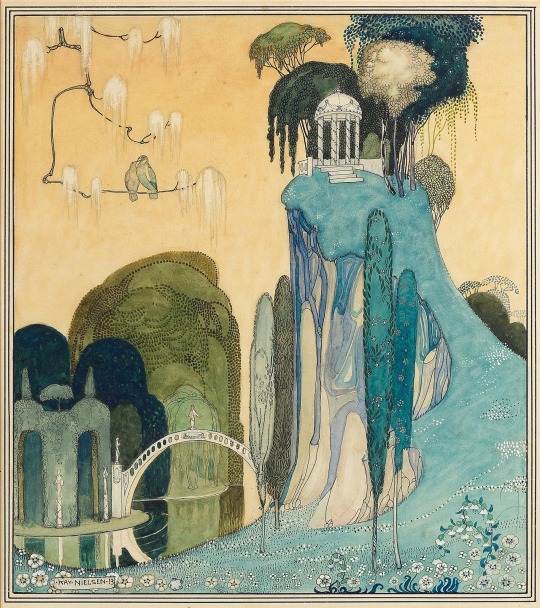



Kay Nielsen "In Powder and Crinoline" by Arthur Quiller-Couch (1913)
From a previous post and I wanted it included in this group.
17 notes
·
View notes
Text

Wassily Kandinsky - Group in Crinolines (1909)
17 notes
·
View notes
Text
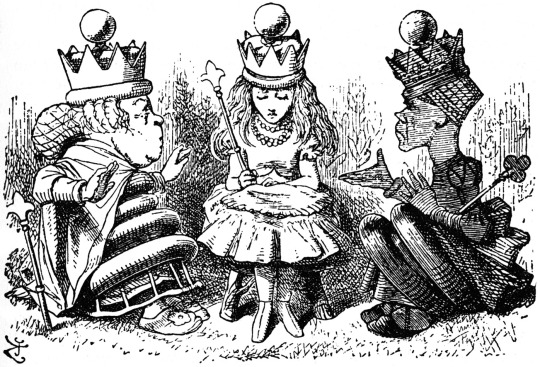
An interesting character in the early days of proto Aristasia is Miss Helen Gilmour, or sometimes known as Miss Helen Baird or Miss Anne Gilmour. She seemed to be a member during their earliest days of the Madrian faith, and seemed to stick with them until the later half of the 1980s. A much more detailed timeline about her activities with the girls from St. Bride's can be found on the Madrian Deanic Resources blog. But, today I find myself thinking about a breif article from 1999, written about her time with the group. No scans of this particular newsclipping have been dug up, but the text version is found archived online:
With her hair pulled back in a bun, her full-skirt and blouse, Helen Gilmour looks every inch a sensible, middle-aged woman. It is hard to believe that she once gave up a promising career to join a cult whose members dressed in Victorian crinolines, and hosted dormitory romps for women dressed as schoolgirls. Now she gives advice on cults to people in the Bradford area.
HELEN GILMOUR was a civil servant in London when she spotted an advert in Private Eye. It was publicising a magazine produced by The Church of the Goddess - linked with a cult known as the Lux Madriana or Light of the Mother, and later known as Rhennes, after the Welsh goddess Rhiannon.
Intrigued, she sent for a copy. "It appealed to something in my imagination. I found it fascinating."
She went to a gathering of cult members. She recalls: "I didn't know what to expect. There were only five of us, but it was a moving ceremony. It had an impact on me. I was 29 and until then the only religious experience I'd had was as a child at the local Methodist church."
To the chagrin of her family, Helen, who lives in Great Horton, left her job with the Ministry of Agriculture and joined the 20-strong group full-time. She was initiated as a Lady of the Temple. She says: "It was like a confirmation and involved a 24-hour fast and all-night vigil."
The group settled in a rambling old house in Ireland, and practised a form of goddess worship based on a female creator and female dominance on earth. Says Helen: "It was an organised form of religion but it was in some respects very disorganised. It was stressful."
She puts this down to the policy to reject modern machinery and technology. "It was supposed to be a traditional, rural farming community, but it didn't work. There was not enough land to run a farm and none of us was competent enough. We had a donkey and poultry and we dug the ground, but we weren't achieving anything.
"People had to appear busy, but had nothing to do. There was a spiritual malaise, a lack of discipline and organisation which ruined the community - it filtered down from the leadership."
Television was banned - Helen still does not own one - and washing was done in old-fashioned dolly tubs. There were no electric lights and they cooked on a range or open fire.
The women wore Victorian crinolines, long cloaks and bonnets, and covered up their faces with veils. And when they opened a holiday "school" for women, offering the chance to re-live schoolgirl romps such as picnics, midnight feasts in the dorm and canings, the Press had a field day. Says Helen; "We needed to raise funds so we advertised the fantasy role-play holiday."
Although disorganised, the cult was strictly hierarchial, with a mistress of the house as boss. There were no overtones of violence or self-destruction which have made other groups, such as the Jonestown and Waco cults, so terrifying.
Helen claims she was not brainwashed, but adds: "There was something sinister at the heart if it. The founder was a remarkable person but was leading a fantasy life - we were living in someone else's fantasy."
Helen left after two years. Now 51, and a secretary at Leeds General Infirmary, she recalls her days in Ireland with affection. "I discovered a freedom, and talents that I didn't know I had."
She is a leading authority on cults and helps others through the Cultline, based at St Joseph's RC Church, Pakington Street, off Manchester Road, Bradford, of which she is an active member.
There are a couple lines I keep thinking about: ""People had to appear busy, but had nothing to do. There was a spiritual malaise, a lack of discipline and organisation which ruined the community - it filtered down from the leadership."" ... "Helen claims she was not brainwashed, but adds: "There was something sinister at the heart if it. The founder was a remarkable person but was leading a fantasy life - we were living in someone else's fantasy."" I keep thinking about the idea that what ruined the community was the lack of organization, and the idea that they were simply living in someone's fantasy, and looking back at all of the things the Aristasian group did, I feel like we can see this clearly. The constant jumping around between ideas, how Aristasia went from a fairly mundane paganism group, to ancient matriarchy, to school-girl roleplay, to Victorian secession, to BDSM heavy vintage fashion, to online roleplaying, to anime and purity culture, and ultimately to Japanese language study. Each one lasting about 5 years or so. But throughout all of these things there *has* been a strong set of religious beliefs that seemed to justify each of these things, no matter how much they contradicted the other incarnations.
#miss helen baird#Miss Helen Gilmour#Founding Mothers of Aristasia#proto aristasia#Aristasia#Rhennish#the silver sisterhood
4 notes
·
View notes
Text
Fashion's Poet of Black : YAMAMOTO
by Suzy Menkes, for the New York Times (2000)
For the first time in recent fashion memory, black — essential, existential black — is no longer the ultimate symbol of cool. Black has dominated designer dressing, just as it has clad the entire fashion profession, since the wave of Japanese style swept over fashion in the early 1980s.
But now color has burst into the autumn clothes. Bright hues and subtle patterns are challenging dark and monochrome — and nowhere more so than from the designers for whom black was once the only fashion creed.
Yohji Yamamoto has built a career on proving that black — aggressive, rebellious, somber, romantic or seductive — is beautiful. He, more than most designers, is the poet of black, the director of fashion's film noir. In fact, a celluloid version of his favorite men in black was shown Saturday at the Venice film festival, where Yamamoto designed the costumes (not to mention the loud jewelry) for "Brother," a new movie by Takeshi Kitano about the yakuza, Japanese gangsters.
What is the lure of black that Yamamoto has been addicted to it since he first graduated from fashion college in Tokyo in 1969?
"Why black?" says Yamamoto, sitting in his Paris studio, black beard and black hair above a dense black honeycomb sweater, mat-black pants and black sneakers flashed with scarlet.
"Black is modest and arrogant at the same time," he says. "Black is lazy and easy — but mysterious. It means that many things go together, yet it takes different aspects in many fabrics. You need black to have a silhouette. Black can swallow light, or make things look sharp. But above all black says this: 'I don't bother you — don't bother me!"'
All this is said with a merry smile that belies Yamamoto's reputation as a designer of clothes for earnest intellectuals. Recent collections have shown rather a whimsical sense of humor: the Inuit-inspired autumn line with its russet paisleys and furry hoods, and the 1998 "wedding" show, in which a bridal "striptease" took models from inflated Victorian crinolines to slim-line dresses and pants.
For men, the art-director image of black suit with truncated proportions, shown on brawny-to-scrawny guys, has also been replaced by a more macho, even rock-star look. (As recreation, Yamamoto plays guitar or harmonica with a group called Suicide City.)
Yamamoto cut his fashion teeth in his widowed mother's dressmaking business, but rebelled at the clients' arriving with magazine styles to copy.
"At the very beginning, I just wanted women in men's style," he says. "Typically Japanese women were wearing imported and very feminine things and I didn't like it. I jumped on the idea of designing coats for women. It meant something for me — the idea of a coat guarding a home, hiding the woman's body. Maybe I liked imagining what is inside."
When an avant-garde buyer gave Yamamoto his first corner in a store, he was faced with what he calls elliptically "very strong competition" and "the start of my Olympic games." He was referring to the designs of Rei Kawakubo, his long-term partner and fashion picador under her label Comme des Garcons. Together — yet with entirely separate aesthetics — they created dark shrouds, asymmetrically cut in fluid, indeterminate shapes, and sheltering sweaters that clothed the acolytes of the all-black cult.
Of course, Japanese designers did not introduce black to 20th-century fashion, as witness the Parisian elegance of Coco Chanel's little black dress or Yves Saint Laurent's tuxedo, and rebellious style from Beatniks through Marlon Brando. But there was an abstraction, a modernism and a lack of visual definition in the work of fashion's avant garde that seemed to be layered in meaning, in the spirit of Mark Rothko's "dark" paintings.
Yamamoto, born in 1943, describes a "lost" postwar generation, educated to look to America or Europe and ignore Japanese tradition. So when his experiments in pushing the boundaries of shape and proportion were hailed as "Japanese" style, he was baffled.
Yamamoto sees his original look emerging from punk. His first collection was presented in Tokyo in 1977 and in Paris in 1981 when the "Japanese" (including Issey Miyake and Kenzo Takada, who were five years his senior) seemed diametrically opposed to everything that French fashion stood for: its well-defined cut and silhouette, its familiar fabrics, its conception of female allure and coquetry. Even 15 years later, when Carolyn Bessette Kennedy favored Yamamoto's designs in the mid-1990s, her choice of flat-plane, dark clothes to frame her good looks still seemed revolutionary.
The French electronic musician Jean-Michel Jarre once defined Yamamoto's style like this: "His work is totally different from anything else. I like the quasi-religious approach he has to fashion. For me, a woman in Yohji is like a nymphomaniac nun. His clothes are at once sensual and very ritualistic."
That phrases captures the eroticism lurking under the skillful tailoring of a purist exterior. In his genuine affection for women, Yamamoto stands apart in a fashion world where male designers tend either to idolize or to dislike the female sex. He admits that "my life is thinking about women."
"First my mother — last my daughter," he says. "And in between are all the secret ones."
Mother, daughter and son (who has brought him a granddaughter) all work in the business: His mother is the revered directrice; his daughter was launched in March, after three years as pattern cutter, as designer of the ready-to-wear line called Y's bis Limi. The proud father claims, "She'll be strong — she'll be bigger than me."
Yamamoto's career reached its zenith with the 1998 "wedding" collection. It confirmed the new, romantic path he had taken as he shifted register from masculine to feminine. The catalyst was his study of haute couture. He pored over the neo-Edwardian gowns of the American designer Charles James at the Brooklyn Museum of Art in the summer of 1999, when he was in New York to pick up an American Fashion Award. In the jigsaw of pattern pieces he uncovered "another designer's process."
The museum has now asked him to curate a fashion exhibition from its archives. It will open in autumn 2001 and thus commemorate the anniversary of 20 years showing in Paris, although Yamamoto says he is thinking not of his past but of "tomorrow and the day after tomorrow." At 56, he thinks vaguely of retiring and of fulfilling his ambition to write. He worries that others might think, "Yohji, you have sung your song already."
A recent Yamamoto signature has been the swoop of a back, from the geisha-esque curve of the nape through the base of the spine to the neo-Victorian bustle.
"This is my fetish idea for a woman's body," he says. "I like the back curve line of women. I am always watching the silhouette in the streets. The rib cage and the hip is very important for me. The image represents the back of a woman. I'm always following her. Don't go! Don't leave me!"
Don't count on Yamamoto, or his women, turning their backs on black.
11 notes
·
View notes
Text
Card Costume Directory (Year One, Second Half)
All event cards are placed under their own tag to be grouped together properly, but this list is to help people find the exact costume they might be looking for. The list is in order of release. This post goes from after the 0.5 anniversay event (Secret Distance) until the 1st anniversary event (Scramble Fan FESTA!).
Secret Distance - Hide Crinoline - Nestle Crinoline
Resonate with you - Dream Chaser - Dream Maker
STRAY BAD DOG - Vivid Soul - Vivid Crew
Tell Me Your Problems! Exciting Picnic - Fairy Tale - Forest Tale
Break Time for the Hardworking You! - Crown Penguin Dress - Tiara Penguin Dress
A Song of Vows for You, Dressed in Pure White! - Traum Singer Tuxedo - Blau Rose Tuxedo
Wonder Magical Showtime! - King of Smile - Happy-Happy Clock Rabbit
Carnation Recollection - Carnation Dress of Reminiscence - Dawn Sky-colored Gradation Dress
Colorful Festival - Blue City Summer Dress - Memorial Heart Coordination
Unnamed Harmony - Aurora Rainbow Coat - Petit Rainbow Coat
Awakening Beat - Beast Heart Girl - Beast Heart Buddy
Ringing Sounds at the Summer Festival - Burning Dawn Matoi - Cooling Dusk Matoi
This'll Definitely Be the Best Summer! - Sunset Beach Girl - Marine Shell Girl
Happy Lovely Everyday! - Messenger of Love - Messenger of Hope
Mesmerized by Mermaids - Mermaid Water Dress - Jellyfish Tuxedo
The Two Moon Rabbits - Idol Rabbit Who Dreams of the Moon - Rocker Rabbit Who Chases After the Stars
Knock the Future!! - Fullmetal Heart - Braveful Heart
Mirage of lights - Snow White Foggy Dress - Lily Bell Foggy Dress
Colorful Festival - Graceful Sekai Dress - White Heart Cardigan
Scramble Fan FESTA! - Hopeful Frills Coordination - Pure Heart Frilly Jacket - Pure Flower Tuxedo
2 notes
·
View notes
Text
“My French modiste has assured me that delicate colors, like this green”—Lady Emily ran a hand down the beaded bodice of her gown—“are all the rage in Paris. And everyone knows Paris is the leader in fashion.”
“Parisians are very stylish.” Miss Luna’s expression was open and amiable. “The dressmaker who created this lovely gown lived in Paris for many years. Her late husband was a diplomat, and when he died, he left her a sizable portion, which she used to open her own dress shop in Mexico City.”
“She went into service?” Lady Emily sputtered, pressing a hand to her chest.
Miss Luna’s brows knit together. “I’ve never considered what Señora García did a service, but I suppose you could say it was.”
“What did you consider it, then?” Avery asked.
“Artistry.” Running her black-lace gloves along the intricate stitching that graced the front panel of her gown, Miss Luna smiled. “Some artists coax beautiful notes from piano keys and violin strings, while others combine oils and canvas and produce vivid scenes that rob us of breath. Señora García takes fabric and thread, and creates masterpieces that are worn for the whole world to see.”
Gideon's breath hitched in his throat. What an intriguing way to think of fashion, as art and beauty. He wasn't sure he agreed, remembering how ungainly the wide crinoline skirts appeared to be.
Still, he moved a step closer to the group as if an invisible string reeled him in.
Ana María and the Fox (The Luna Sisters, #1) by Liana De la Rosa
#book quote#ana maria and the fox#liana de la rosa#the luna sisters#ana maria luna veldes#gideon fox#historical romance#romance#quote#quotes#booklr#bookblr
3 notes
·
View notes
Text
WE MADE THE ROBOT DOG PISS BEER
[VIDEO START]
MR GRIST: What’s up MeTube! Today I teamed up with the City Filia to throw the biggest and best party the Entertainment wedge has ever seen!
Grist nation before we start I need you to smash that subscribe button. Let’s get into it.
[drone footage overlooking the Entertainment Wedge where hundreds of people have gathered in the streets]
MR GRIST: The first thing we need for a party is food, so we teamed up with the Charity Foundation to help feed every single person in the wedge for FREE for AN ENTIRE DAY.
[footage of Herald performatively packing boxes of groceries with the rest of his team]
MR GRIST: Between fruit products, protein products, and vegetable products, everyone is getting a balanced breakfast, lunch, and dinner!
[footage of Herald outside the Center for Control]
MR GRIST: We also need booze, it’s not a party without it! You saw the video title, you already know!
WE MADE A ROVER PISS BEER! WE ARE THE FIRST AND ONLY ONES TO DO IT!
[several quick shots of phlegmatics and cholerics enjoying the food and drink]
MR GRIST: Last but not least, we need music! Hit it!
[the camera pans to an empty DJ booth which lights up and begins to synthesize a new pop hit]
MR GRIST: You already KNOW we got Ent.io on the beat!!!
[Herald throws himself back into a group of teenage phlegmatic girls, and begins to dance feverishly]
[suddenly he stops and throws up a hand, causing his dance partners to stop too]
MR GRIST: Guys! Wait! We almost forgot the best part!
[everyone around Herald goes silent, the DJ booth reduces its volume, and someone passes him a microphone]
MR GRIST: Introducing, for her first ever public appearance, Princess Daphne of Yellow Bile!
[Daphne descends a sweeping stairway at the front of the crowd, flanked by two Rovers in patrol mode. She is dressed in a yellow silk gown with puffed crinoline sleeves.]
[the crowd screams and applauds thunderously. Herald begins chanting her name and others begin to take up the call]
[DAPHNE approaches the podium at the base of the stairs and waves a hand to quiet the crowd]
DAPHNE: It is my greatest honor to make my public debut amongst our wonderful community and family. We are so lucky to have one another. To be encompassed by our loving, peaceful walls. Truly, here, we want for nothing, except perhaps even more hours in the day, so that we might accomplish even more.
But enough about work, now is the time for play!
[the music revs back up and DAPHNE is surrounded by Yellow Bile courtiers, insulating her from the phlegmatic crowd]
[credits roll over the massive dance party]
CREDITS: Special thanks to Filia Special Forces, The Charity Foundation, Mr Grist Burger, and all glory to John and Hella above
[END VIDEO]
#weird fiction lovers come get yall juice#mr beast#satire#cholericposting#going grist mode#daphneposting#church of blood#entioposting#mr beast rpf#Daphne coalescence spoilers
1 note
·
View note
Text

On this day:
DANCE WITH FIRE
On August 27, 1938, Henry "Mack" McAusland watched as his fiancée's dress burst into flames after a dance at the Shire Hall in Chelmsford, England. Phyllis Newcombe, a twenty-two-year-old candy-shop assistant, and her partner had been celebrating the start of soccer season at the community event and were departing when she suddenly screamed from the bottom of the stairs. Mack was astonished to see her white satin and tulle dress on fire.
A group of men dashed out from the ballroom; the newspaper editor wrapped his heavy tweed coat around her, suffering singed eyebrows and burns in the process. The police and ambulance were called, but the one ambulance in town was already responding to a different emergency. So it was some time later before Newcombe was transported to the hospital. Unfortunately, the incident was not only unexplainable, but also fatal.
At the inquest the coroner suggested that the dress caught fire when a cigarette touched the crinoline. The young woman's father objected. Producing a piece of fabric that his daughter's dress had been made from, he held a lit cigarette to it, and the material would not ignite. It was also suggested that a lit match had somehow fallen from the floor above and, remaining lit, jumped to the hem of Newcombe's dress, causing the combustion. A lighter held to the skirt would set it on fire; however, Newcombe was standing alone when the incident took place, and witnesses swore that no one attending the affair had a lighter. The coroner concluded it was accidental death due to an unexplainable fire. He commented, "I must say, that in all my experience I have not met with anything so very mysterious as this."
Text from: Almanac of the Infamous, the Incredible, and the Ignored by Juanita Rose Violins, published by Weiser Books, 2009
1 note
·
View note